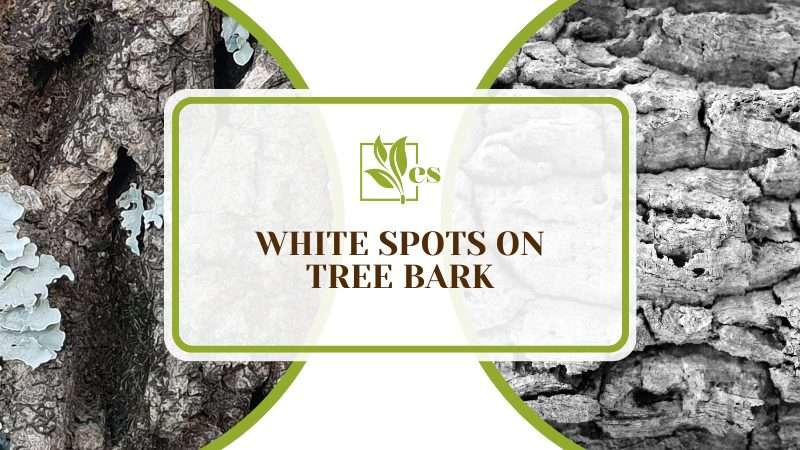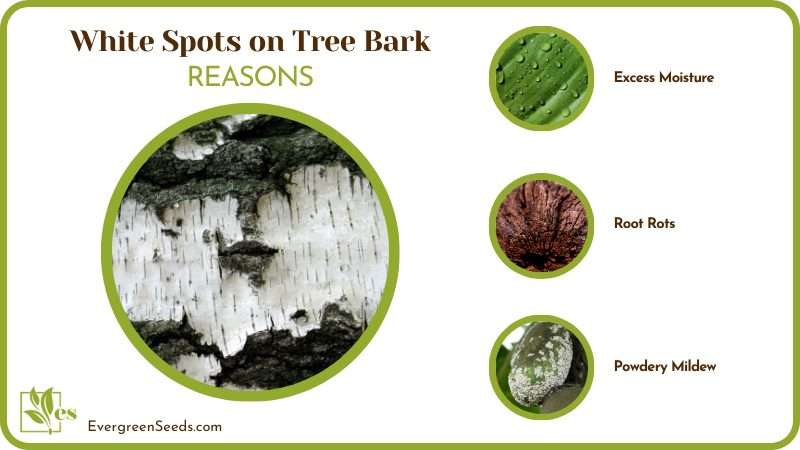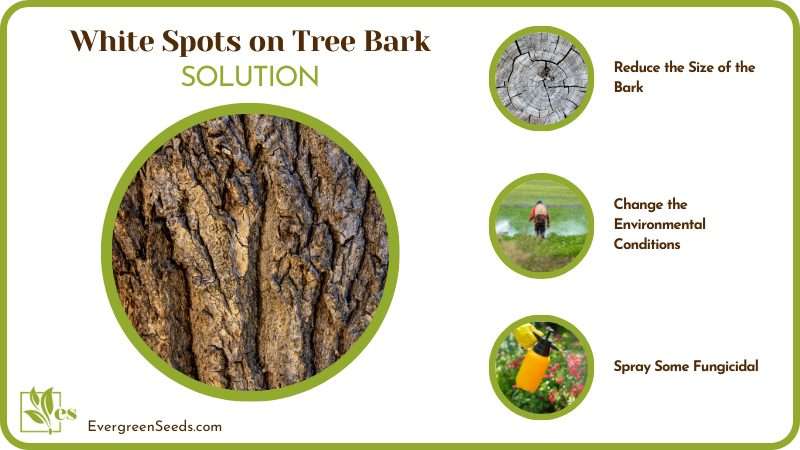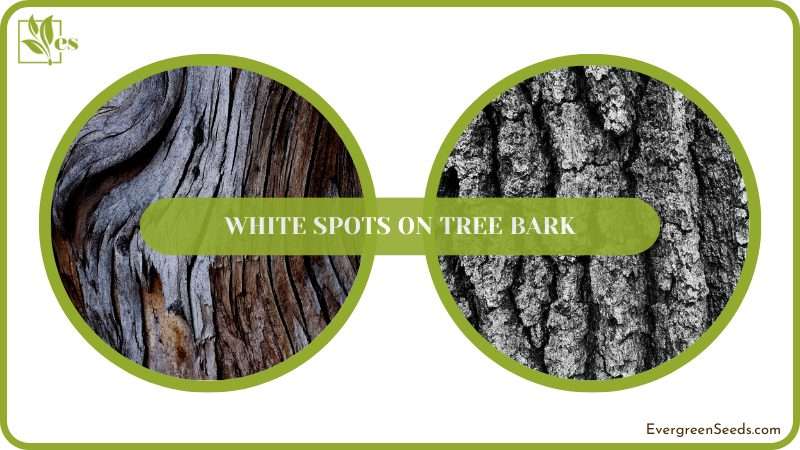White spots on tree bark is a problem that can be seen, and some could be more dangerous than others. You may be alarmed at the sight of those white things on your trunks, but the situation is actually reversible in most cases.

We’re here to help you discover what’s that white thing bothering your tree and how to analyze and treat the situation successfully. Depending on your tree there are two main culprits so let’s talk about them.
JUMP TO TOPIC
What Are The Most Common Causes of White Spots on Bark?
The most common causes of white spots on bark are due to excess moisture, and root rot. It could also be due to powdery mildew, or even the oat wilt fungus. These issues would result in white dots that would be seen on the bark of the tree. This can happen to any type of soil, even though some soils can drain water quickly.
– Excess Moisture
White spots on tree trunks and bark are a commonplace occurrence when you have your tree exposed to excess moisture, and this could be an environmental factor. Almost always these white spots are caused by some type of fungi interacting with the tree tissue. You can sometimes breathe a sigh of relief if the problem is only just visible on your bark.
Think of bark the same as the base cover of the tree, and if it’s cut, the infection will first begin at the point where the wound is, and the fungus will grow. However, if the tree hasn’t been wounded you’re likely dealing with something more deadly.
Some tree species will be more susceptible than others. For example, evergreen trees like pines won’t have a hard time dealing with fungi, while sap-bleeding trees like oaks or maples will bleed a lot and have far more fungal disease issues than others.
The excess moisture would permit fungi to enter the tree through cut wounds, and from there find their way to the roots. Sometimes even soggy and waterlogged soil may be a medium, but these conditions will likely cause a different set of problems.
– Root Rots
Several types of rots can attack your trees before they show white growth on the bark. But we recognize the two most common ones — heart rot and Armillaria rot, which are cases of root rot.
For instance, if you take heart rot, this is a fungal disease that you should be most afraid of. It begins at the root ball of your tree, spreading to the tissue and eating your tree from the inside out. This means that by the time you spot white things emerging on your bark, your tree has probably already been contaminated fully.

If you’re lucky enough to discover somehow that when you’ve cut your tree the tissue is already black and white, you may save your tree but the window to do so is quite short. If the disease has progressed to almost the point of no return, you will notice this by white spots and ooze protruding from various places on the bark.
In the last stages, the disease will form white fungus-like lesions on the bark, and you will know that large portions of the wood are gone. There’s some joy in knowing that this disease will only occupy already weak and dead parts of the tree, leaving the live tissue alone.
Armillaria rot is another root-breeding fungus that reproduces in the root ball and progresses to the upper parts of the tree. With hundreds of tree species being susceptible to it, there are plenty of symptoms coming with the disease, but again, they will show little dots on the tree’s trunk.
Light and bleached bark wood is a common sign of this rot and chlorosis and diebacks of branches and twigs. Infected conifers will also exude excess resin and develop bark cankers. If your tree is a larch or birch, you can count yourself lucky, as these are resistant to this fungal disease.
– Powdery Mildew
The first one is surely powdery mildew, being the most common of all fungal diseases that can appear on both the canopy and the bark, which would be alarming signs. Remember that this one is a common infection affecting a wide range of trees and plants.
When it comes to trees, magnolias, maples, dogwoods, and oaks are highly susceptible to this disease. This disease will mostly attack your young plants in development, appearing as a white sooty mold on the bark. In prolonged cases of infection, trees’ leaves may turn yellow, brown, and even fall off.
– Oat Wilt
Oak wilt is another tree disease that will attack oaks specifically. It will usually appear as autumn has set in — your leaves going yellow and brown in spring or summer as well. You will see them look weak and wilted, instead of looking healthy.
Being a fungal disease, this will likely happen when the season is rainy, hot, and humid. This disease spreads rapidly, and eventually, the leaves develop yellow spots on the dark brown surfaces and fall off, and the disease begins to spread to weak branches and trunk parts.
How To Deal With The Diseases of White Spots On the Bark?
To deal with the diseases of white spots that are on the bark, you should reduce the size of the bark, and change the environmental conditions. Lastly, if the fungus hasn’t been tackled so much, you can spray some fungicidal spray.
Now that we know that your white spots can be caused by both inner fungal issues and outer diseases, you’ll probably know what to look for when identifying your enemy. Identification is everything when it comes to nurturing the tree back to health.
– Reduce the Size of the Bark
Once your tree is infected by rot, there’s no set-in-stone proven way that can help you treat the tree, so prevention is your best bet. If your trees have been damaged severely you may want to reduce them back to stumps to promote the new development. If rot sets in an already weakened tree, you’ll be left with little to work with, so you might as well give yourself a clean slate.
Wounds, injuries, and dirty tools are all things that will largely increase the chances of the tree getting infected, which is why when you start to reduce the size of the bark, it decreases the risk of letting the fungus grow bigger. To prevent the rotting of the roots, always use disinfected and clean tools, and don’t cut large portions of bark all at once.

On another note, try to shape your trees early on to manage a healthy canopy and avoid cutting large limbs as large wounds will make your trees prone to mold and fungal attacks. As a result, it would be good if you could thin it so that the tree wouldn’t get harmed.
– Change the Environmental Conditions
When it comes to external fungal diseases like powdery mildew, prevention is the best sidekick. Avoid overwatering your trees and keeping them in humid environments with no air circulation. Always look to plant your trees in well-lit spaces with lots of airflow. Also, space out your trees to give both the roots and canopies of grown specimens some breathing space.
Regularly prune small branches and twigs to keep the aesthetic and ornamental value of the tree, keeping a good airflow capability at the same time.
– Spray Some Fungicidal
If your tree does show some white stuff on the bark you don’t need to worry too much about powdery mildew, as the condition isn’t fatal. You can always spray a commercial fungicide on the tree and help it fight off the disease — these can however be toxic to your trees, especially fruiting ones.
For a more homely and natural fungicide, you can always use a mixture of neem oil or baking soda with water and spray that on your trees. These are more organic fungicides on the tree if you wouldn’t like to use any chemicals. Make sure that you would spray them in spring and summer.













